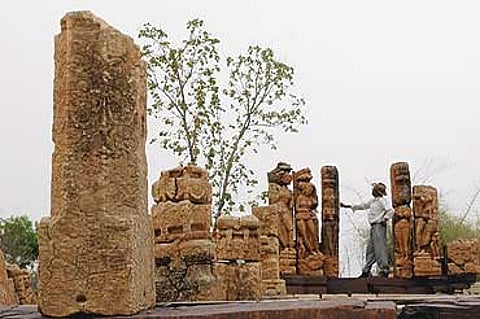Given the large number of temples, it's almost certain that religion had an important place in the lives of the residents. "It's an integrated multi-religious complex," says Indira Mishra, the bureaucrat who heads the task force on Sirpur. The fact that temples of Buddha, Shiva and Vishnu have all been unearthed here indicate a tolerant, harmonious society. The Shivalingas are in four colours—white, red, yellow and black—meant to be worshipped by the Brahmins, Kshatriyas, Vaishyas and the Shudras respectively. Many of the temple sculptures are also erotic a la Khajuraho. Others show depictions from the Panchatantra tales. Some display copulating animals.
Of the 108 Shiva temples identified, two have been revealed in entirety. Both face west. One of them is a pancharatna temple with beautiful carved designs on bricks on the exterior of the garbh-griha (sanctum sanctorum). And it houses a one-metre tall, fully intact Shivalinga. The most outstanding feature of this temple is the presence of two huge stone slabs carved with Baiga figures. (Some 1,500 years later, Baiga figures continue to be carved in the same fashion today by the Gond-Maria tribals in Chhattisgarh). Some of the temples seem to have been constructed by the rulers while others were built by the people themselves.
In order to understand habitation patterns of the ancient site, two residences have been exposed. Both belong to Shaivite priests and are located just south of the temples. Both the houses are two-storied structures and have three rooms and a verandah each. Both face the temple and have a room each on the first floor that is without any entrance. These rooms, probably, served as a granary and were accessed through a hole in the floor. The size of the granary is a fair measure of the number of inhabitants of a house. Interestingly, grain is still stored in Chhattisgarh in exactly the same manner. Iron locks and stone-grinders have also been unearthed.
Sharma speculates that a mighty flood in the Mahanadi River probably swallowed the city, the cataclysmic event having traumatised the residents into abandoning the site. "It seems they locked their houses and escaped, never to return," he conjectures. Subsequently, a thick forest overran the site, burying the city. But even before the floods, forests were always close to the city and pugmarks of wild beasts have been discovered on stones unearthed from the site.
The excavation work at Sirpur will be suspended during the monsoons to resume after the rain ceases, says Indira Mishra. Experts opine that with Sirpur having so many Buddhist viharas, it surely must have had a stupa too. Hiuen Tsang has also referred to a stupa at Sirpur. Trying to locate and expose that stupa is also on the agenda. To know further about the ancient city and its dwellers, it is proposed next to disinter more residential sites, especially the residential complex of the royal entourage.
The work in Sirpur is far from complete. In fact, only a very small percentage of the identified mounds have been exposed. Till date, only 20 mounds have been fully excavated, eight of them within the last oneyear. But Sharma refuses to be overwhelmed by the enormity of the task beforehim. "We will excavate and expose only as much as we can maintain," hesays. The digging and discovery continue. The 4th century rises to meet the 21st.
Holy Earth Rising
It's bigger than Nalanda and Bodh Gaya. A 4th century Buddhist/Shaivite site is discovered in Chhattisgarh.

Published At:
Tags